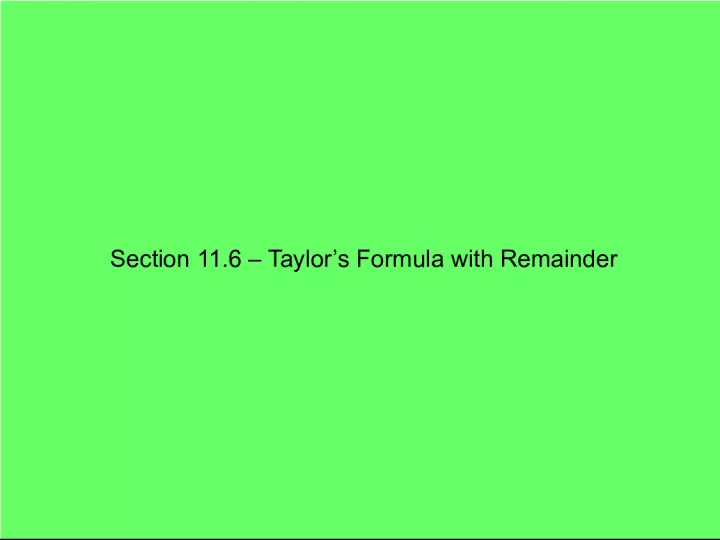Taylor's Formula and Error of Taylor Polynomials


Learn how to find a Taylor polynomial of 3rd degree for f(x) on [0,1] and estimate f(0.5) using Lagrange Remainder and M.
- Uploaded on | 1 Views
-
 carter
carter
About Taylor's Formula and Error of Taylor Polynomials
PowerPoint presentation about 'Taylor's Formula and Error of Taylor Polynomials'. This presentation describes the topic on Learn how to find a Taylor polynomial of 3rd degree for f(x) on [0,1] and estimate f(0.5) using Lagrange Remainder and M.. The key topics included in this slideshow are . Download this presentation absolutely free.
Presentation Transcript
Slide1Section 11.6 – Taylor’s Formula with Remainder
Slide2The Lagrange Remainder of a Taylor Polynomialwhere z is some number between x and c The Error of a Taylor Polynomial where M is the maximum value of on the interval [b, c] or [c, b]
Slide3let f be a function that has derivatives of all orders on theInterval (-1, 1). Assume f(0) = 1, f ‘ (0) = ½, f ”(0) = -1/4, f ’’’(0) = 3/8 and for all x in the interval (0, 1). a. Find the third-degree Taylor polynomial about x = 0 for f. b. Use your answer to part a to estimate the value of f(0.5)
Slide4let f be a function that has derivatives of all orders on theInterval (-1, 1). Assume f(0) = 1, f ‘ (0) = ½, f ”(0) = -1/4, f ’’’(0) = 3/8 and for all x in the interval (0, 1). c. What is the maximum possible error for the approximation made in part b?
Slide5estimate the error that results when arctan x is replaced by
Slide6estimate the error that results when ln(x + 1) is replaced byF ‘’’ (x) has a maximum value at x = -0.1
Slide7find an approximation of ln 1.1 that is accurate to three decimalplaces. We just determined that the error using the second degree expansion is 0.000457.
Slide8use a taylor polynomial to estimate cos(0.2) to 3 decimal placesIf x = 0.2, Alternating Series Test works for convergence
Slide9Use a Taylor Polynomial to estimatewith three decimal place accuracy. Satisfies Alternating Series Test
Slide10Suppose the function f is defined so thata. Write a second degree Taylor polynomial for f about x = 1 b. Use the result from (a) to approximate f(1.5)
Slide11Suppose the function f is defined so thatc. for all x in [1, 1.5], find an upper bound for the approximation error in part b if
Slide12The first four derivatives ofa. Find the third-degree Taylor approximation to f at x = 0 b. Use your answer in (a) to find an approximation of f(0.5) c. Estimate the error involved in the approximation in (b). Show your reasoning.
Slide13The first four derivatives ofa. Find the third-degree Taylor approximation to f at x = 0 b. Use your answer in (a) to find an approximation of f(0.5)
Slide14The first four derivatives ofc. Estimate the error involved in the approximation in (b). Show your reasoning.